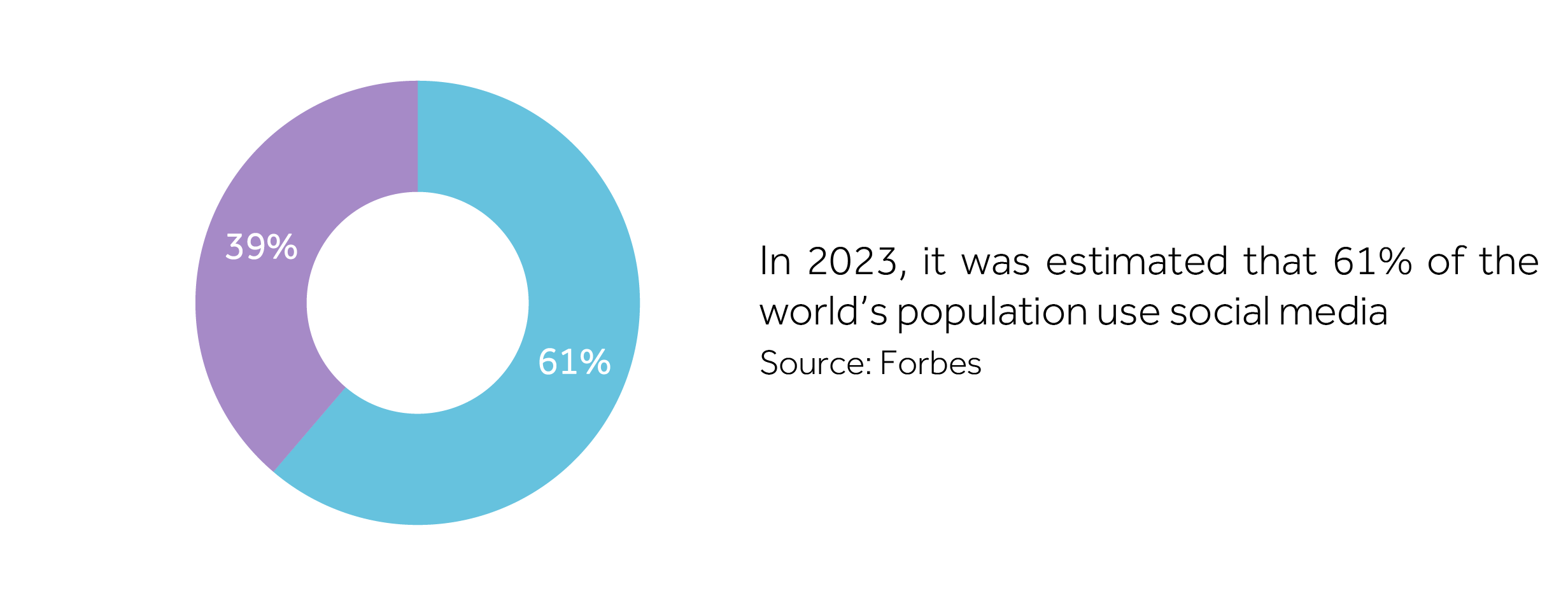
Introduction
In a world where time is one of the most valuable assets, it’s astonishing to realize that the average person spends nearly two and a half hours each day on social media.
 With 4.9 billion people across the globe now part of this digital landscape, social media has become one of the most powerful forces. It shapes opinions, drives movements, and connects billions across the globe. But what makes it so influential? The answer lies in the algorithms that silently work behind our screens, determining the content we see, the connections we make, and ultimately, shaping our entire online experience.
With 4.9 billion people across the globe now part of this digital landscape, social media has become one of the most powerful forces. It shapes opinions, drives movements, and connects billions across the globe. But what makes it so influential? The answer lies in the algorithms that silently work behind our screens, determining the content we see, the connections we make, and ultimately, shaping our entire online experience.
Decoding the Mechanisms Behind Algorithms
An algorithm is a set of mathematical instructions that processes data to produce specific outcomes. In social media, algorithms are responsible for maintaining order, ranking search results, and ensuring that feeds remain organized and relevant.
Here’s how it works: Algorithms take inputs from a user’s past behavior on the platform, such as the posts they have liked, the profiles they follow, and the content they have interacted with. These inputs serve as data points that the algorithm analyses using mathematical rules to predict what content the user is most likely to engage with next.
 For example, if a person frequently likes and shares posts about travel, the algorithm “learns” this preference and begins to display more travel-related content. The output, in this case, is a feed tailored to that individual’s interests, with content ordered in a way that maximizes their engagement.
For example, if a person frequently likes and shares posts about travel, the algorithm “learns” this preference and begins to display more travel-related content. The output, in this case, is a feed tailored to that individual’s interests, with content ordered in a way that maximizes their engagement.

Understanding the Forces Behind Algorithmic Decisions

Source: Sprout Social
The Journey from Recency to Relevance
Over the past 15 years, the evolution of how content is delivered on digital platforms has been nothing short of transformative. Initially, social media platforms prioritized recency, displaying posts in reverse chronological order to keep users updated with the latest content. However, as user bases grew and content volume exploded, this method proved insufficient.
The shift began in 2009 when Facebook introduced a personalized, algorithm-based feed tab, marking the first major move toward relevance over recency. By analyzing user behavior—such as likes, shares, and interactions—platforms began to prioritize content that would resonate more with each user.
This focus on relevance was further emphasized in 2014 when Facebook began prioritizing native video content and trending topics while demoting business-related posts and click-bait. Pinterest followed suit in 2015 with a machine-learning algorithm that determined the “pinnability” of content in the home feed, enhancing user engagement and curating a more tailored experience.
By 2016, most major platforms had adopted algorithmic feeds that ranked content based on relevance rather than recency. Instagram and Twitter both launched their algorithmic timelines. These changes reflected a new era in content delivery, where the focus had shifted entirely from merely showing the latest posts to presenting the most relevant content.
This evolution continued well beyond 2016, with platforms like TikTok, which became a prime example of the power of algorithm-driven content delivery. TikTok’s ‘For You Page,’ where users spend most of their time, is a testament to the platform’s reliance on sophisticated algorithms to serve highly relevant content.
The Real Deal with Algorithms: Why They Matter?
As social media platforms expanded, so too did the volume of content. In economic terms, this created a classic supply and demand imbalance—an oversupply of content met by the finite attention spans of users. Consumers, inundated with more content than they could possibly consume, began to experience diminishing returns on their time spent online. This is where algorithms, the digital equivalent of Adam Smith’s “invisible hand,” stepped in, to balance this equation.
-
From a Consumer’s Perspective:
In a world overflowing with posts, videos, and updates, algorithms became essential. With the average person globally spending around 145 minutes daily on social media, it’s clear that these platforms have become a significant part of daily life. Over a typical lifespan of 73 years, this translates to more than 5.7 years spent scrolling, liking, sharing, and interacting online. Algorithms help users navigate the clutter by curating content that matches their interests. It’s like sorting through a huge pile of information to find just the right pieces, making time spent online more enjoyable. Instead of getting lost in endless content, algorithms ensure that users quickly find what matters most to them, enhancing their online experience.
-
From a Business Perspective:
For businesses, the introduction of algorithms was less about saving users from content overload and more about driving revenue. In a competitive digital landscape, capturing attention is currency. A striking 76% of users have purchased something they first discovered on social media, and algorithms play a pivotal role in this process by directing the right content to the right eyes at the right time, converting casual browsers into loyal customers. Essentially, algorithms have become the engine behind targeted advertising, tailored recommendations, and personalized experiences—all of which keep users engaged longer. The longer the engagement, the more opportunities there are to serve ads, sell products, and ultimately boost the bottom line. This is why 41% of businesses now rely on social media as a key revenue driver. In essence, algorithms are not just shaping online experiences; they are redefining consumer behavior and the very mechanics of modern commerce.
Conclusion
As we reflect on the evolution of social media algorithms, it’s easy to feel nostalgic for the days of chronological feeds, where posts appeared in the order they were shared, seemingly free from the invisible hand that now guides our online experience. However, the reality is that chronological feeds are themselves a form of algorithm—just a simpler one. In today’s digital world, where content is endless and time is limited, such a straightforward approach is not viable. Algorithmic recommendations exist to solve the very problem of information overload.
For companies, these algorithms provide a unique advantage by allowing them to target specific groups with personalized content. By leveraging the data-driven nature of algorithms, businesses can optimize their reach, identify trends, and build stronger connections with their audience.
However, it’s not all sunshine and rainbows. These same algorithms have also fostered the creation of digital “bubbles,” distorting the perception of reality. By continuously serving content that aligns with individual preferences and beliefs, algorithms often reinforce existing views, blurring the line between truth and fiction. In doing so, they create echo chambers that limit exposure to diverse perspectives, making it difficult for individuals to break free from their curated content. This insular experience can hinder critical thinking, as people may find it increasingly challenging to distinguish between authentic information and manipulated narratives designed to reinforce pre-existing biases.
To address both these realities, the focus needs to shift towards responsible use of algorithms. Businesses must continue to harness their potential, but with an emphasis on ethical practices that avoid exploiting these bubbles for profit. On the user side, platforms can introduce tools that encourage exposure to diverse content and offer greater transparency about how algorithms shape their experience. By fostering a balance between personalization and diversity, it’s possible to ensure that algorithms remain a force for connection and discovery, rather than isolation and manipulation.
References:
- Forbes (2024)
- Columbia University (2023)
- PwC (2023)
- International Review of Information Ethics (2017)
- Rad AI (2023)
- D Custom (2017)




